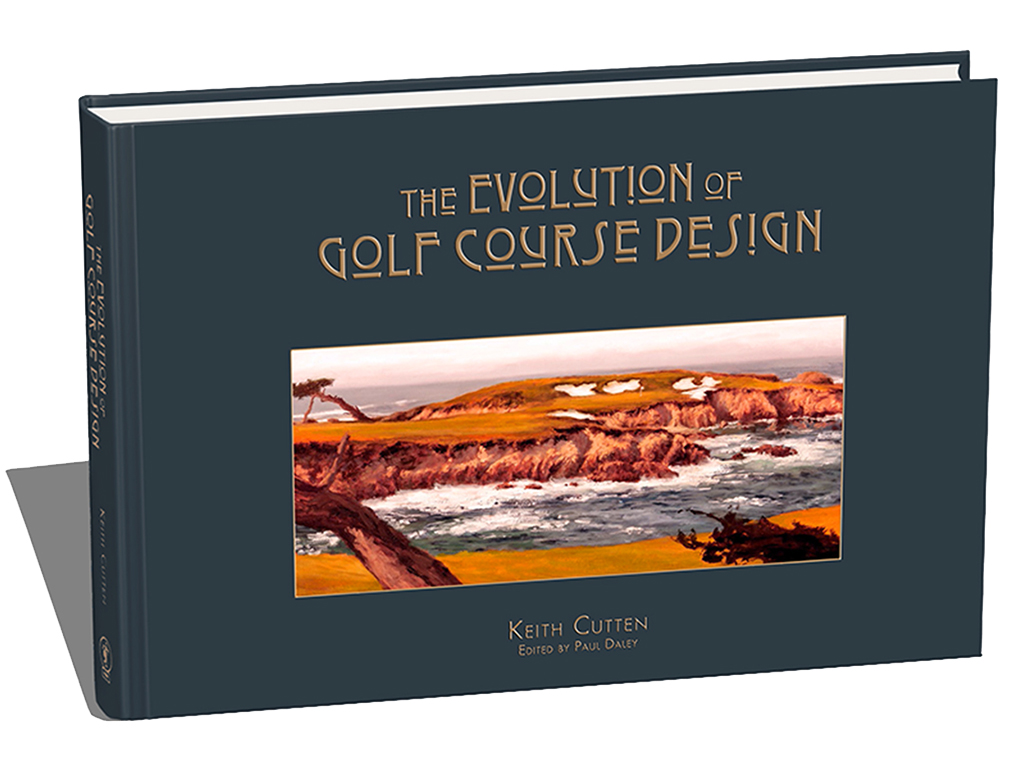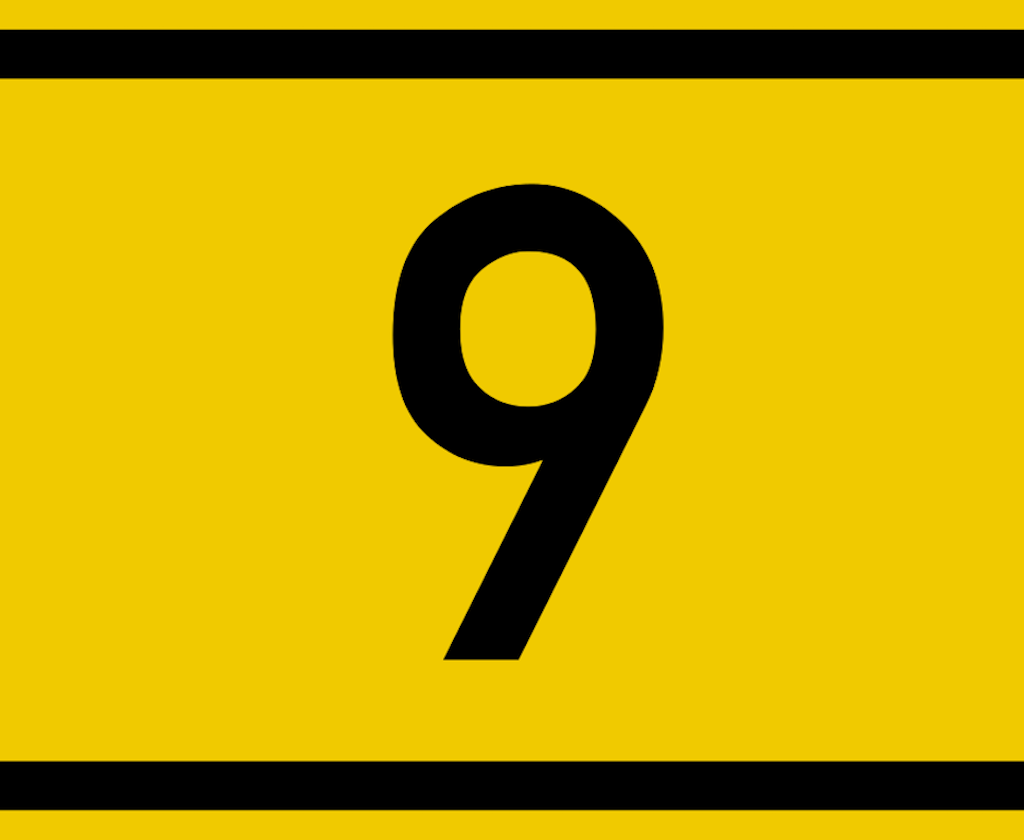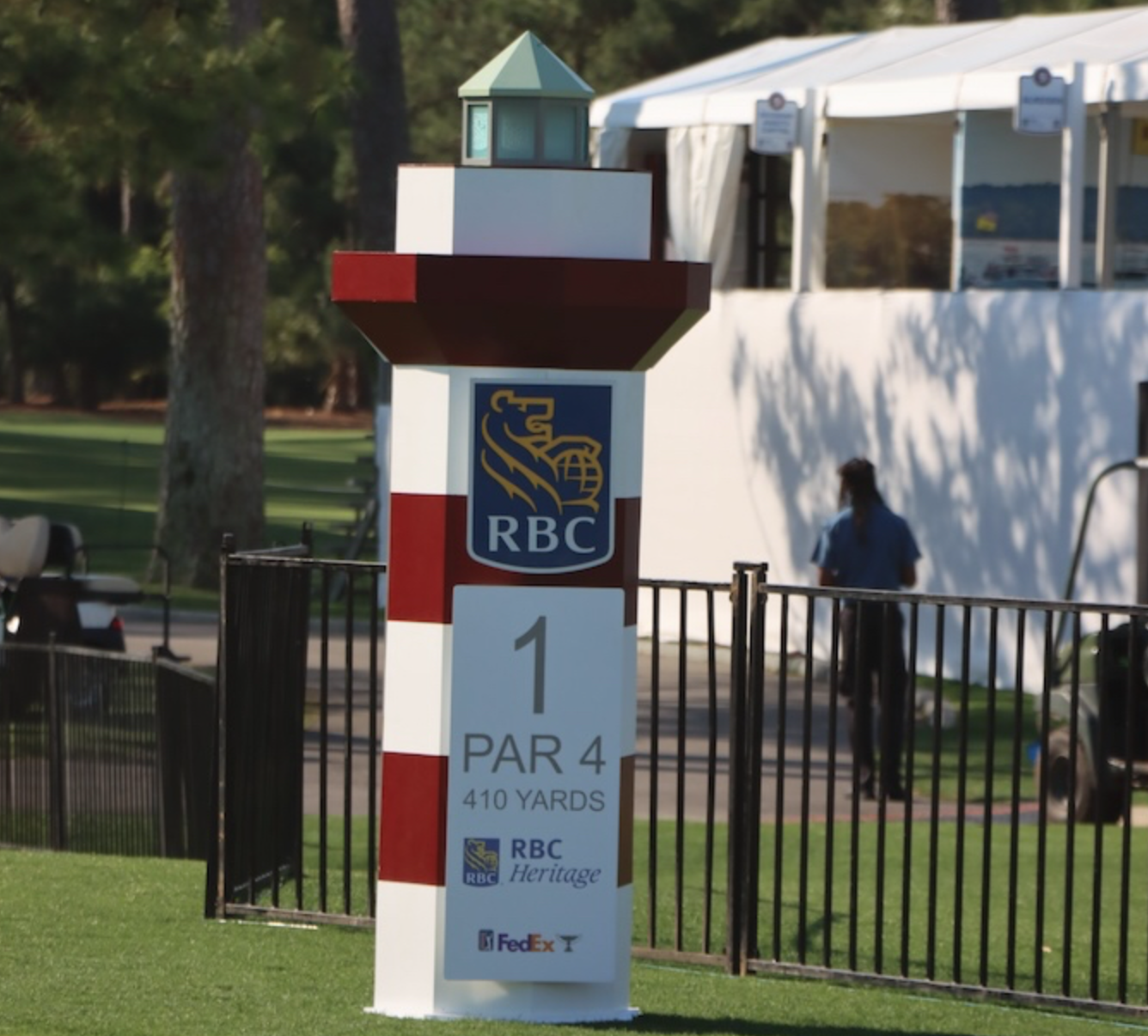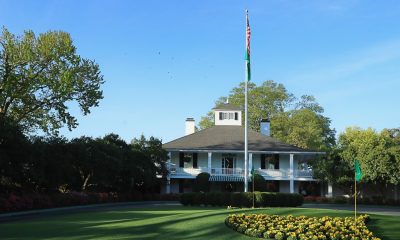News
An interview with Keith Cutten, author of “The Evolution of Golf Course Design”

This interview is with Keith Cutten, author of “The Evolution of Golf Course Design,” which is a new book he is releasing to the public. This is an unbelievably well-researched and all-encompassing look at golf course architecture, how it has changed throughout history, and all of the variables in play that have shaped it over the course of time.
Let’s start with the easy stuff. What’s your personal background? How did you get into all of this?
Well, my passion for golf architecture started back in high school. I took a drafting and design curriculum all through high school, which was hugely beneficial. I was getting into golf around 15-16 years old and I lost my grandfather, who was the primary golf influence in my life. When he died, he left me his golf clubs, and I missed him so much I just dove completely head first into golf.
When I finished high school, I sat down with my dad to try to hash out a game plan to get into the golf industry. My dad was an environmental scientist for 40 years with the Ministry of Environment in Ontario, so he helped me a great deal in understanding the policy system here in Canada. I started by getting my bachelor’s degree from the University of Waterloo in Planning and Environmental Design. In my last coop term, I went for broke and I reached out to Rod Whitman in Canada, who invited me to do a 5-month coop with him during the construction of Sagebrush Golf & Sporting Club in British Columbia. The pay was paltry and I ran a shovel and a rake for most of the summer, but I fell in love with it instantly.
I later went back for my master’s in Landscape Architecture at the University of Guelph, which I finished in 2016. The culmination of that was my thesis, which has now become this book. Nowadays, I have my own company, Cutten Golf, Inc., which allows me to partner with people like Rod and Dave Axland, who has been Coore and Crenshaw’s chief project manager for 30 years. I couldn’t have walked into a better situation as a young, aspiring architect. To have the opportunity to work with these guys is incredible.
Having had the opportunity to peek at an advanced copy, I can say the book is completely fascinating. Talk a little bit about what compelled you to devote so much of yourself to this pursuit in the first place.
I’m the type of person that needs to answer my own questions to be satisfied. I’m not comfortable with just accepting things as fact without knowing the story behind them. I was sitting in one of my first master’s classes, which was basically a history of the landscape architecture profession. I’m learning how everything is influenced by society and wars and economy and I thought, “This has to be true for golf, but no one’s ever talked about it.”
At the time, I was also batting around ideas for my thesis. I was thinking a lot about the renovations that had recently been done to Pinehurst No. 2 and I was particularly curious about how Donald Ross’s original design was so much more environmentally sound than what it had been allowed to become over the course of time.
One of the key quotes that I got from Bill [Coore] about that project was that they were not trying to be “environmental crusaders” so much as they were just trying to put the course back to the way Donald Ross had originally intended it. So the question I kept asking in my head was, “How did this happen?” I sort of went on a fact finding mission to uncover how golf course architecture changed and it kept snowballing. I just kept following leads in different directions that began to connect all the dots for me. I went a little deeper down the rabbit hole every day, and ended up with a 600+ page thesis to turn in.
Just to paint a quick picture for the readers as to what’s going on in the book, there’s two main sections to it. The first section is going through history decade by decade starting with the early origins of golf, then 1830s, 1840s, and so on. I don’t want you to give too much of your book away, but give people a taste for what’s going on there.
Essentially, there’s a lot of short little blurbs about historical context that I try to quickly tie into golf. I suppose you’d have to start with the Victorian era, which was the first attempt at going away from the “links” style of architecture. When people from urban areas (say London) found golf and wanted to play it, they wanted to create their own courses so they wouldn’t have to travel over to St Andrews. So, the professional golfers of the time built what they could. The only people that were doing construction of the landscape at that time were the crews that were building state homes for the ultra-wealthy in the Victorian style. So they wound up with golf courses that were built much the same way with features that were geometric and square. They looked nothing like the links courses of Scotland.
After that, there was then a shift into what’s called the Arts and Crafts movement that takes you into the 1910’s. WWI had a huge impact at that time. Britain was basically devastated after WWI, so a lot of architects fled to the US, the land of opportunity, which led to what we now call the Golden Age of golf course architecture.
Shortly after that period, you have the Great Depression and WWII, where all of this knowledge that had been built really just comes to a halt. After going through the Great Depression and WWII, society really didn’t want to think about the past. There was no fondness for what had been done, so modernism became the way of life for basically everyone at that point, including golf course architecture.
Most of the big name architects (Ross, Mackenzie, etc) started their careers back in England before WWI, so when you get to WWII, those guys are all either dead or retired. It was a perfect storm which basically took golf in a completely different direction.
The second part of the book is profiles on golf course architects, authors, and visionaries. So you go from Old Tom Morris to Geoff Shackelford and everywhere in between. Given how much time you’ve invested in this, I’m curious to know who you would put on the Mount Rushmore of architects and why?
I’m going to flavor this with my own personal bias, but for me number one has to be Harry Colt. He’s so brushed over in North America it’s crazy. He pioneered what golf course architecture is, which is combining strategy and naturalness. Colt’s influence can be seen in work of Dr. Alister MacKenzie (Australia and America), Hugh Alison (Japan), Stanley Thompson (Canada) and Donald Ross (America). His influence just can’t be overstated in my opinion.
Stanley Thompson would have to be my next choice. Especially since I’m Canadian. His projects have defined great golf here, and his influence on me was immense.
Third would be Bill Coore. Without Sand Hills, I don’t think we are where we are today when it comes to golf course architecture. I don’t think anyone is reading my book and I doubt I’m even writing if it wasn’t for Bill. I think he’s the Alister Mackenzie of our time.
Last would be Rod Whitman. He just doesn’t get the notoriety or the acclaim that he deserves in my opinion. Bill Coore sings Rod’s praises all the time. He even gives Rod credit for figuring out how to make his routing work at Friar’s Head. I’ve learned so much from Rod and a lot of my passion for architecture comes from him.
If you had the opportunity to sit down with one of these people (dead or alive) you profiled over dinner, who would it be and what questions would you ask them?
I think it’d have to be Stanley Thompson. He was the type of guy that was notoriously larger than life. It’s rumored that he made and spent multiple fortunes in his lifetime according to his biography. He’s the type of guy that could sell the Canadian rail lines on the idea that they should build a golf course up here in the middle of nowhere because it’d be good for their business. I just think if he’s anything at all like what those stories would lead you to believe, that’d be a hell of a dinner.
I do want to ask about one specific aspect if you don’t mind because I personally find it super interesting and I think our readership would as well. Can you talk a little bit about the relationship between golf course equipment and architecture? Let’s kind of go down that rabbit hole for a minute.
I think the biggest misconception is that Golden Age architects never saw these kinds of advances in equipment coming. They did. They experienced their own advancements with equipment. The Golden Age didn’t start in the US in the 20s and 30s. Those same guys were designing courses in England in 1910 and prior to that, so they had already seen advancements of their own. They did react to them very differently than what has been done up until the last 10 years, however. They used the contour of the ground and width and angles in such a way that if you didn’t play to the right area of the fairway, you didn’t have a shot. The way they combated length is to put an emphasis on placing your shot in the right location instead of just pounding it down there as far as you can.
Even back then, there were some instances where people could hit 300-yard drives because you have to remember this was before irrigation. This brought the ground game into play. It wasn’t lawn darts where you hit every shot a certain distance and stopped it on a dime. Even though a long hitter might be able to get a drive out there 300 yards, that shot likely wound up in a pot bunker if you weren’t super precise with it. Back then, it was so much more a three dimensional game where you had to think about all the little humps and bumps and what they might do to the golf ball after it landed. The Golden Age architects were already thinking about this stuff when they designed their courses.
For a long time, we basically forgot our own history. Everyone after WWII just tried to reinvent the wheel by pinching landing areas and growing the rough taller, which was terrible for golf. We’re relearning, though, that combating length isn’t done by making courses longer and narrower; it’s done by making them shorter and wider. I think we need to start showing a bigger variety of golf courses on television. I think the tour is doing that with places like Trinity Forest, but they need to stop listening to the whining of players. That cannot be our measuring stick for whether or not a course is good.
Right or wrong, what gets shown on TV is what gets exported everywhere. One of the messages with my book is that that has to stop. Every course should not aim to be Augusta. They should aim to be what they are, and that requires completely understanding and committing to what that is.
Lastly, give us a call to action. Tell us how to get in touch with you and learn more.
Sure! To learn more about me, my business, or my book, the best way to do that is to visit my website www.cuttengolf.com. @cuttengolf is my handle for both twitter and Instagram.

Keith Cutten, author of The Evolution of Golf Course Design
- LIKE66
- LEGIT4
- WOW4
- LOL2
- IDHT0
- FLOP1
- OB1
- SHANK1
News
Morning 9: Rory: I’m not joining LIV | Masters ratings | Nelly: We just need a stage

|
- LIKE1
- LEGIT0
- WOW0
- LOL0
- IDHT1
- FLOP0
- OB0
- SHANK0
Tour Photo Galleries
Photos from the 2024 RBC Heritage

GolfWRX is on site this week at Harbour Town Golf Links on Hilton Head Island for the RBC Heritage. Plenty of golfers who competed in the Masters last week will be making the quick turnaround in the Lowcountry of South Carolina as the Heritage is again one of the Tour’s Signature Events.
We have general albums for you to check out, as well as plenty of WITBs — including Justin Thomas and Justin Rose.
We’ll continue to update as more photos flow in from SC.
Check out links to all our photos, below.

General Albums
- 2024 RBC Heritage – Monday #1
- 2024 RBC Heritage – Monday #2
- 2024 RBC Heritage – Tuesday #1
- 2024 RBC Heritage – Tuesday #2

WITB Albums
- Justin Thomas – WITB – 2024 RBC Heritage
- Justin Rose – WITB – 2024 RBC Heritage
- Chandler Phillips – WITB – 2024 RBC Heritage
- Nick Dunlap – WITB – 2024 RBC Heritage
- Thomas Detry – WITB – 2024 RBC Heritage
- Austin Eckroat – WITB – 2024 RBC Heritage
- Xander Schauffele – WITB – 2024 RBC Heritage
- Jason Day – WITB – 2024 RBC Heritage
- Will Zalatoris – WITB – 2024 RBC Heritage
- Patrick Cantlay – WITB – 2024 RBC Heritage
- Ludvig Aberg – WITB – 2024 RBC Heritage
- Collin Morikawa – WITB – 2024 RBC Heritage
- Sam Burns – WITB – 2024 RBC Heritage
- Stephen Jaeger – WITB – 2024 RBC Heritage
Pullout Albums
- Wyndham Clark’s Odyssey putter – 2024 RBC Heritage
- JT’s new Cameron putter – 2024 RBC Heritage
- Justin Thomas testing new Titleist 2 wood – 2024 RBC Heritage
- Cameron putters – 2024 RBC Heritage
- Odyssey putter with triple track alignment aid – 2024 RBC Heritage
- Scotty Cameron The Blk Box putting alignment aid/training aid – 2024 RBC Heritage

- Cameron putter – 2024 RBC Heritage
- Odyssey Ai One Eleven T putters – 2024 RBC Heritage
- Christian Bezuidenhout – testing new Callaway Ti 340 mini driver – 2024 RBC Heritage
- Rory McIlroy testing the new TaylorMade BRNR Mini Driver Copper – 2024 RBC Heritage
- Xander Schauffele testing the Callaway Ti 340 mini driver & the DUW – 2024 RBC Heritage
- Byeong Hun An, two new L.A.B. Golf putter builds with “T” alignment – 2024 RBC Heritage
See what GolfWRXers are saying and join the discussion in the forums.
- LIKE9
- LEGIT0
- WOW0
- LOL2
- IDHT0
- FLOP1
- OB0
- SHANK0
News
Morning 9: Aberg: I want to be No. 1 | Rory’s management blasts ‘fake news’ reports

|
- LIKE1
- LEGIT0
- WOW0
- LOL0
- IDHT0
- FLOP0
- OB0
- SHANK0
-

 19th Hole1 week ago
19th Hole1 week agoDave Portnoy places monstrous outright bet for the 2024 Masters
-

 19th Hole3 weeks ago
19th Hole3 weeks agoThings got heated at the Houston Open between Tony Finau and Alejandro Tosti. Here’s why
-

 19th Hole1 week ago
19th Hole1 week agoTiger Woods arrives at 2024 Masters equipped with a putter that may surprise you
-

 19th Hole2 weeks ago
19th Hole2 weeks agoReport: Tiger Woods has ‘eliminated sex’ in preparation for the 2024 Masters
-

 19th Hole4 days ago
19th Hole4 days agoTwo star names reportedly blanked Jon Rahm all week at the Masters
-

 19th Hole4 days ago
19th Hole4 days agoNeal Shipley presser ends in awkward fashion after reporter claims Tiger handed him note on 8th fairway
-

 19th Hole3 days ago
19th Hole3 days agoReport: LIV Golf identifies latest star name they hope to sign to breakaway tour
-

 19th Hole2 weeks ago
19th Hole2 weeks agoAddiction, spinal fusion, and scam artists – Everything Anthony Kim revealed in candid interview with David Feherty































Chuck
Dec 27, 2018 at 4:00 pm
Well those are sure some interesting comments about advances in equipment technology and architecture.
15th Club
Fuggedabooitit
Dec 24, 2018 at 8:25 pm
Would you call the Extreme 19th Hole in South Africa an evolution? How about some of the Dye-abolical Pete type courses? Are they evolution or just mickey-mousing the silliness and taking it to stupid places that the terrain and the game itself can provide?
Dolla
Dec 23, 2018 at 8:34 pm
The last bit about the whining of players has nothing to do with it.
It’s to do with how many grandstands and concession stands and TV camera towers and positions can they fit on a course, along with the spectators they need to bring in to pay for a lot of things.
Space for all that stuff and a system to generate moneys is why you see a lot of the courses that you do.
Don’t just blame it on the course designs, don’t just blame it on what the players say.
Yes the Tour does set up courses for better scoring, and even the USGA has caved into that with all the rules changes to make it easier to do so.
But course designs you see on TV is mostly due to the amount of room the equipment needs to live and make room for the fans to be there, so they can support with their money
ogo
Dec 23, 2018 at 2:54 pm
Did the 19th and early 20th golf course architects deliberately create many water hazards into their designs?
I can see a water pond reservoir being part of a golf course, but to fill the course with water hazards seems psychologically masochistic and too punishing on the golfer losing expensive golf balls.
This also include dense undergrowth that is impossible to find errant golf balls. Why is punishing water and weeds included in golf course design?